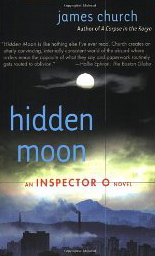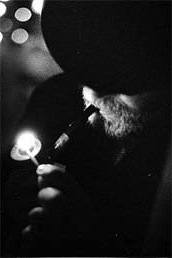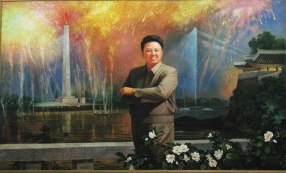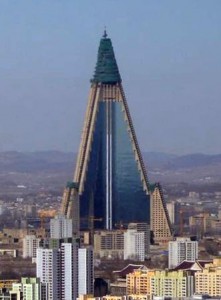“Visitors don’t just show up [here]. The Ministry has an entire wing of people whose job it is to screen visitors, slow them down, think up reasons they can’t be admitted: not yet, not now, not ever. You have a question? The answer is no.”
Author “Jam es Church,” a career diplomat with years of experience in Asia, including, one assumes, North Korea, sets his second mystery starring Inspector O of the Ministry of People’s Security, in the country’s capital of Pyongyang. Though O is an Inspector, he, like those he works with, has no idea who is really in charge of the investigations to which he is assigned. His Ministry is constantly locking horns with SSD, the State Security Department. Turf wars often erupt over jurisdiction and competition for credit is fierce when a case is solved successfully, since budgets depend on solving problems. The Traffic Division has its own interests, and unnamed people from unknown departments of the army or the government sometimes assume control without warning and manipulate outcomes. For Inspector O, the best approach has always been to keep his head down, do what he is told, try to laugh at the absurdities, and close his eyes to the atrocities.
es Church,” a career diplomat with years of experience in Asia, including, one assumes, North Korea, sets his second mystery starring Inspector O of the Ministry of People’s Security, in the country’s capital of Pyongyang. Though O is an Inspector, he, like those he works with, has no idea who is really in charge of the investigations to which he is assigned. His Ministry is constantly locking horns with SSD, the State Security Department. Turf wars often erupt over jurisdiction and competition for credit is fierce when a case is solved successfully, since budgets depend on solving problems. The Traffic Division has its own interests, and unnamed people from unknown departments of the army or the government sometimes assume control without warning and manipulate outcomes. For Inspector O, the best approach has always been to keep his head down, do what he is told, try to laugh at the absurdities, and close his eyes to the atrocities.

Church reproduces Inspector O’s uncertainties and confusion about cases throughout the structure of his novels. Whatever confusion O may have about what is going on, who is doing what, or who is in charge, is matched in the reader, who obtains his information directly from O. This creates a free-flowing, often disjointed narrative which can ultimately be as frustrating for the reader as it is for Inspector O, and there are times when a reader can be forgiven for coming close to abandoning the novel because nothing seems to connect. Until the end, of course–always a blockbuster filled with surprises.
Hidden Moon continues the story of O’s life after The Corpse in the Koryo, and readers who have read that novel will have a decided advantage as they read this one. This novel is more complex than its predecessor, and knowing the recent history of the Ministry, O’s role in it, and the backgrounds of certain characters who repeat here prepare the reader for the many threads that unwind before they even begin to be tied together. A shocking robbery at the Gold Star Bank, the first ever in Pyongyang, challenges the Ministry and Inspector O, especially since O is not called to deal with it until a week after it has happened. Nothing has been entered into the duty log, and there is nothing in the training manual that says that bank robberies are part of the Ministry’s responsibilities. Still, the Ministry is ordered to solve the crime by the end of the month.
 O quickly discovers that someone, somewhere, is controlling his access to information, and he realizes that he and the Ministry are being set up to fail. One of the robbers, thought to be from Kazakhstan, has been hit by a bus and killed while removing a silk stocking from his face as he crosses a busy street. Though the morgue denies that they have the body, O is able to obtain the silk stocking the man was wearing. Private guards, not government security, have been on duty at the bank, and one of them has left immediately before the robbery. Strange characters who seem to be involved in a local bar called Club Blue, where a murder takes place, also seem to be connected to people at the bank. The bank manager is not cooperative. Nothing there was insured. The government says it wants the foreigners who use the bank—people involved in necessary business and trade with the country—to have their sense of safety and security restored, but O cannot obtain any information to help him solve the case.
O quickly discovers that someone, somewhere, is controlling his access to information, and he realizes that he and the Ministry are being set up to fail. One of the robbers, thought to be from Kazakhstan, has been hit by a bus and killed while removing a silk stocking from his face as he crosses a busy street. Though the morgue denies that they have the body, O is able to obtain the silk stocking the man was wearing. Private guards, not government security, have been on duty at the bank, and one of them has left immediately before the robbery. Strange characters who seem to be involved in a local bar called Club Blue, where a murder takes place, also seem to be connected to people at the bank. The bank manager is not cooperative. Nothing there was insured. The government says it wants the foreigners who use the bank—people involved in necessary business and trade with the country—to have their sense of safety and security restored, but O cannot obtain any information to help him solve the case.

“First the Ministry wanted the case solved, then they didn’t. And then they did. SSD was thrown in, so quickly it almost seemed to me that someone had planned their involvement all along…” O says. “I was used to opaqueness in these things, but this exceeded what was normal. And now there were warning streamers attached to the normal little warning flags, all telling me that guessing wrong on this case would not be minor.” As O just tries to get along and do his job—or not do his job, if that is what is expected of him—the manic uncertainties of his situation, and of life itself in Pyongyang, become ever more obvious. “Ah, I love it when the plot thickens,” he notes with dark irony.
As iconoclastic and irreverent as O was in Corpse in the Koryo, he has graduated to mordant satire in his view of life here. With his tongue firmly set in his cheek, he openly directs his sarcasm toward those who seem to be in charge, their conversations sometimes so bizarre that they resemble those of The Three Stooges. As the ironies of his life turn into absurdities and threaten to turn the investigation into the farce that O believes it to be, he becomes a far more engaging character than he was in the previous novel. Acts of kindness and sympathy also show him to have heart at the same time that his courage and control allow him to survive beatings and torture. With an unusual mixture of dark hu mor and violence, Hidden Moon recreates the frazzled and frantic life of a mid-level bureaucrat in the country’s capital and casts light on a life that offers little hope of improvement.
mor and violence, Hidden Moon recreates the frazzled and frantic life of a mid-level bureaucrat in the country’s capital and casts light on a life that offers little hope of improvement.
Also by James Church: THE MAN WITH THE BALTIC STARE, the third book in the series.
Notes: James Church is widely respected among diplomats and on sites dealing with foreign relations. See the Notes at the end of the review of A CORPSE IN THE KORYO for more information.
This photo of “James Church”by Peter Kolk is the only one known to exist for this former diplomat. http://us.macmillan.com
The painting of Kim Il Sung, the Eternal President, appears on the site of Steve Smith, who went to Pyongyang with the New York Philharmonic Orchestra in 2008. www.nightafternight.com
The Ryugyong Hotel, “the 17th tallest skyscraper in the world…was going to be the tallest hotel in the world when construction began 1987. It was going to have 3000 rooms and no less than 7 revolving restaurants. The only problem? Construction halted in 1992 when it was still just a concrete shell. Construction has recently resumed. The building, as of February, 2009, is here: http://en.wikipedia.org. The unfinished building dominates the Pyongyang skyline, as one can see on this site: http://subjunctive.net
